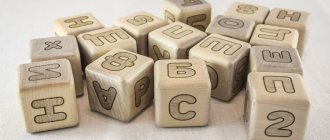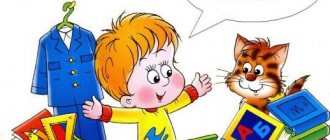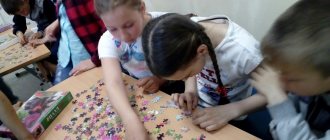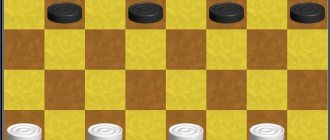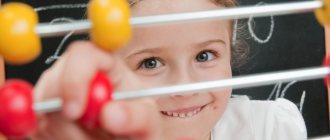Interesting articles
Summary of mathematics classes in kindergarten according to the Federal State Educational Standard
All parents want their child to be smart and successful in life. At five years old, children already know a lot and can carry on a small conversation and draw conclusions. Some children can even read at this age. Currently, there are a lot of different circles, sections and clubs for the development of preschoolers. Many parents want to prepare their child for school and send him to various preparatory courses. But don’t forget that this is a child, he wants to play and have fun. In order not to harm the baby and not to discourage him from learning, you need to understand his desires and follow them, slightly guiding him towards development and learning. If your child likes board games, he is diligent, and you have noticed an interest in chess. Then you should send him to the chess section or start studying at home. Provided that your playing skills allow you to do so. For a child of 5 years old, chess is the most appropriate time to start learning.
The benefits of chess for children
“Without chess it is impossible to imagine the full development of mental abilities and memory. The game of chess should enter into life as one of the elements of mental culture.” V.A Sukhomlinsky is a talented Soviet teacher and writer.
If your child is hyperactive and likes chess, support his desire, as it develops perseverance and discipline. If you want to develop your child's intelligence, be sure to try teaching him to play chess.
The first steps in learning should begin with close relatives; if mom and dad do not have the appropriate knowledge, this could be grandparents. After studying the pieces and basic knowledge, you can send your child to the chess section. You will not regret it because the benefits of playing chess are obvious:
- develops the thought process;
- the baby becomes diligent and attentive;
- gives an understanding of the consequences of his actions, teaches him to be responsible;
- develops logical thinking;
- teaches you to think outside the box;
- teaches you to analyze the actions of the enemy and predict his behavior.
The importance of chess for child development
What chess develops in younger children:
- To set a goal and diligently pursue it - you need to build connections, logical chains and calculate the right path to victory. Children cannot do this, but the game of chess allows you to gradually expand the scope, increase the number of tasks, and transform possible ways to complete them.
Chess
- Thinking that allows you to make non-standard decisions within the framework of your system of actions is also very important. The framework imposed on us by society, parents, and school is a limiter of our capabilities. And chess allows you to break down boundaries, step over them and see the world that opens up outside.
Note! The child does not yet have enough experience to use the standards. He begins to learn to build logical chains and does not understand that there may be limitations somewhere, so his mind looks for ways to solve his problems where an adult applies standards.
- Willpower and endurance. Interest in sports and the desire to win cultivate willpower. The kid understands that if you try and think, your efforts will be rewarded. Chess teaches that in order to achieve a certain result, sometimes it is necessary to wait for time, to choose cold calculation rather than emotions. Perseverance also develops willpower and builds character.
- Calculating all the moves and patterns in chess to determine the most profitable solution is training logical thinking and mathematical abilities. Methodology for teaching chess like real life: the loss of some assets (chess pieces) in life (chess game) with rational calculation provides an advantageous position.
- Creativity is also developed through playing chess. The children lead the game like a play: they distribute roles, the play of whites and blacks is like good and evil, a tragic ending for one and a triumphant end for the other. In any case, an open chess lesson in a preparatory group will have a sensation, as it will act as a theatrical performance.
- Training concentration and attention with the help of chess will allow the child to be more collected. Stopping at one object and remaining restrained to achieve a goal are of great importance, but children do not understand this yet. Chess develops concentration because it teaches that temporary perseverance will lead to victory.
- Losing is not the end of the world, but that is often how children perceive defeat. Chess games always end in either a loss or a victory – that’s a fact. The understanding comes that this is a normal situation when you can’t win. Therefore, chess classes allow kindergarten students to accept defeat with dignity and not despair. And if you lose, there is a desire for revenge.
Revenge
You need to learn to look failures in the eye and understand:
- Why did it happen so?
- What can be done to prevent this from happening again?
- How to become stronger?
Dance classes for children 3, 4 and 5 years old
Chess from 5 years and older
Your baby is almost five, and you want to start learning, then you need to know that at this age he cannot concentrate on one thing for a long time. The first lessons should be kept very short.
Get a board with chess pieces and just let your child play with them. Next, little by little introduce each figure individually.
You can tell a fairy tale or show a cartoon about chess. The Fixies have a good series about chess:
After learning the names of the pieces and their locations on the chessboard, you can play a game similar to lotto. Place the figures in an opaque bag and let the child put his hand into the bag and determine the name by touch, and then put the figure in its place on the board.
Describe the chessboard and pieces depending on the baby's preferences. If this is a boy and he likes knights, then the board is a battlefield, the pieces are two armies that need to capture the king. If he likes Star Wars, then describe everything in accordance with this plot, you can even buy chess in the form of characters from Star Wars.
The main thing is that the child has initial associations with something familiar to him and that it reminds him of some kind of fairy tale plot.
Tell us how each figure walks and perhaps come up with some story about why it walks that way, depending on the plot you choose. This way the young chess player will better remember all the pieces and how they move.
Compare the figures and build a scale of values for each figure. Which figure is more important and why.
Do not go straight to the game, consolidate your knowledge by creating different problems on the chessboard. For example, place the enemy's pawns on the board and let the kid use one piece to cut down all the pawns in the least number of moves. To study a knight, arrange the pawns in the form of a fence for the knight to jump over and reach the edge of the board. And most importantly, remember, you are teaching a child and you need to present everything in the form of a fairy-tale game, trying not to overload him or force him.
Chess lessons at preschool educational institutions
- Preparatory stage. You can ask parents to talk about chess, how one of their relatives participated in a tournament, offer to read or watch a chess tutorial for children together, or take the child to a place where grandmasters gather. If children get an idea about chess, they can become interested in it.
- Organization of an open chess lesson. You can teach children to draw chess boards in notebooks, recognize pieces, explain what diagonal, horizontal and vertical are. Then you should tell how each figure walks, using diagrams. Rhymes, riddles and songs will help with this.
- Repetition is the mother of learning. After a lesson in the basics of chess, children will remember only part of what they heard, and to consolidate the result, they need to conduct another quest lesson. The child is asked to remember what was said, but in a way that makes it interesting. The presence of parents is welcomed, as the child can boast of his knowledge, and parental approval will consolidate the result. Chess develops not only logic, but also creativity.
Chess play
Advice! Guys and girls can act as figures themselves, because in a team everyone always has their own role: there are princesses, kings, officers and pawns. Do not label, but explain that each figure has a special meaning and plays an extremely important role.
Classes on traffic rules in the 2nd junior groups of kindergartens
Children can be taught chess from preschool age. It develops creativity, logical thinking and allows the brain to work at full strength. Comprehensive teaching of chess to children – in the family circle and in a preschool educational institution – will strengthen the child’s desire to practice and will make it possible to understand that chess broadens one’s horizons, introduces one to new friends and gives priority in the team.
Strategy Basics
After studying the figures, you can move on to strategy. The main points that a young chess player should know:
- the king is the main figure and must be protected;
- seize control of most of the board;
- do not endanger your pieces, each piece must be protected;
- Before making a move, calculate all the moves the enemy can make after your move.
Each figure should have its own value, and the baby should know this:
- Pawn - 1 point;
- Horse – 3 points;
- Elephant – 3 points;
- Rook - 5 points;
- Queen - 9 points;
- The king has no price, because if he is cut down the game will end. This is the most important figure.
The child needs to be given an association, for example, this is 1 point, one candy or one ruble, or something that is important to him, and he knows it well. Or let one point be one pawn, then a knight is three pawns.
Controlling the center of the board.
The figures located in the center acquire more weight in contrast to those who stand on the edge in their original position. They have more options for attack and retreat. The best way to do this is to use knights and pawns. And pieces such as the bishop, rook and queen are suitable for control and attack from afar.
All pieces must be involved.
When most of the pieces remain in their original places, and all the actions are done by a couple of pieces, then at a key moment you may not have enough strength to deliver a decisive blow or repel it. And when a large number of pieces control the field, then victory is inevitable.
Advice on activities for parents
Of course, not all children have a passion for playing chess. But if parents still want to instill a love for such an activity in their child, then it is important to motivate their son or daughter. Even before introducing your child to chess, you need to periodically take out the board and pieces, arrange them, and slowly introduce the child to their names and principles of moves. You can also play several games with family members or friends in front of your child. There are a few more rules and recommendations:
- the first lesson should last no longer than ten minutes;
- answer all the child’s questions;
- the second lesson should also be short, but longer than the first, 15 minutes is enough;
- Before starting classes, you can let your child watch cartoons about chess.
In many ways, the interest of their child in chess depends on the parents. Therefore, be sure to show your son or daughter that you are also interested in the game. After this, the child will definitely begin to enthusiastically ask about various aspects. As soon as you feel your child’s interest and motivation, you can start taking your child to specialized chess courses in clubs or to a tutor . Here the teacher will work with the child. Moreover, such lessons will be very useful: they develop creative and logical thinking, teach winning and losing, and kids will be able to master the skills of creating their own strategies and logical chains of games.
Also, during the courses, the child will be interested in playing chess, as he will see examples of other children. Even the successes of others can stimulate a preschooler to acquire new knowledge and skills. Be sure to support and stir up your child’s interest in such activities. It’s great if someone in the family loves and knows how to play chess. Then you can continue training at home. When the baby is able to defeat his opponents, he will rejoice and have fun. When losing, the preschooler himself will begin to understand that during the game he needs to be more attentive and careful.
How to play with a young grandmaster
- Don't try to beat the baby. If he constantly loses, he will quickly lose interest in the game. Sometimes lose if you see that your little student makes good moves and chose the right strategy, and you can also arrange a draw;
- You cannot lose constantly or often, because after a rare defeat he will be very worried;
- Analyze each game played with your child. Encourage good moves and discuss bad ones;
- You need to play regularly and not take long breaks;
- There is no need to expect quick and serious results from your child, do not put pressure on him;
- There is no need to let the baby walk; he must be aware of the responsibility for the move he makes.
How to teach chess in a playful way
The earlier the process of getting to know chess begins, the more appropriate it will be to use game-based learning techniques. It is important to understand that classes should not be tedious and drawn-out, but rather dynamic and special, awakening the desire to find out what will happen next.
The training should be divided into several stages so that each of them is short, informative and non-standard. You can use different activities:
- test moves or knowledge of pieces;
- additional soldier figures that need to be removed from the board;
- cards with options for moves, order of pieces,
Important!
The main thing is that the learning process should not be a dry retelling of theory.
It would be perfect to use an interesting fairy tale, the heroes of which are pieces, and each of them will receive their own role and actions corresponding to their behavior on the board in the game. The scenario should be thought through and applied constantly, making adjustments to the course of the battle and options for using the heroes of the fairy tale. For young players, the associative series is very important. You can use this option for the names of the figures and their meanings:
- the king has a symbol of power - the crown and therefore the most important, everyone must protect him and follow his orders and moves;
- the queen is the queen, she is next to the king and is always ready to protect him, she has a special status thanks to her crown;
- rook - two important pillars of defense, directly help in it;
- the elephant is a secret protector, his face is hidden under a scarf, that’s why he has this shape;
- a horse is a faithful assistant and friend;
- pawns are soldiers, ready to be the first to join the battle.
Using such parallels, you can further indicate why exactly each figure should move this way and not otherwise. In context, children remember the rules better, and the game becomes an adventure for them, spurring interest and desire to continue it.
See also:
Birthday in Minecraft style - how to organize a party at home
Chess: rules for beginner children
The first lesson begins with an introduction to figures. The baby needs to remember their names. Perhaps he will want to play with the chess pieces as he pleases. Let him do it. If your child likes to fantasize, then you can come up with a fairy tale about a chess country.
the second lesson to telling your child that each piece has a position on the board and the pieces move according to certain rules:
The pawn takes only one step forward on the plane of the board, and eats the enemy piece diagonally. Also, a pawn is promoted to any piece if it manages to reach the opposite edge of the board.
The king can also take one step , although in any direction.
The queen is the most powerful in the entire game. Moves straight, sideways, and diagonally.
The knight has an unusual move: it jumps over the other figures two squares and one sideways. His move is similar to the letter "G".
The bishop moves diagonally the required number of squares.
Rook forward or sideways.
All pieces are removed from the board, and the king cannot be eaten. You can only declare checkmate.
You can devote a separate lesson to each. Then show how they work in conjunction with each other. If the baby is tired, then there is no need to insist on the lesson. This can discourage you from playing the game forever.
Take your time and accompany your learning of the rules with various games:
- Wonderful bag. Hide all the chess pieces in an opaque bag one by one and ask the child to determine by touch which piece you have hidden. For greater effect, let your baby hide the pieces and guess which chess piece is in the bag.
- "Find differences". Ask your child to list all the differences between one figure and another.
- "What's missing." You place all the representatives of the chess pieces on the table and, when the child turns away, you remove one piece. The kid must guess which figure you hid. This game perfectly develops visual memory.
- Modeling chess pieces from plasticine or clay.
- "Cube". Take one of the old cubes, draw each of the six chess pieces on paper, and glue the designs to the faces of the cube. Or glue a cube from whatman paper. Throw the dice one at a time. The thrower must name the figure that appears on the top face of the die.
- "Guessing game." Verbally describe a chess piece to your child and ask him to guess what kind of piece it is. Then switch roles.
- "Forbidden figure" Place the chess pieces in front of the child in one row. At your request, the baby will name all the shown figures, except for the “forbidden” one, which is selected in advance. Instead of naming the forbidden figure, you should say: “Secret.”
- “Let’s play and guess.” Wish your child a chess piece. The kid lists the figures until he names the one he has in mind. Then switch roles.
- "Letter". Ask your child which chess pieces have names that begin with the letters K, L, P, C, F.
- "What common?". Take any two chess pieces and ask your child: how are they similar? What is the difference? (Color, shape).
- "Big and small." Place six different chess pieces in front of your child, ask them to choose the tallest one, name it and set it aside. Then the child will determine the tallest of the remaining figures, etc. At the end of the game, all chess pieces are returned to their place, and a new game begins, in which the lowest chess piece is chosen.
- "Chess house". Build a little house out of cubes, into which the chess pieces will run one at a time, from the smallest to the largest. The child must name each of them.
- "Chess turnip" Plant a turnip. Next to her, the child lines up chess pieces according to their height, explaining: “Grandfather is a king, grandmother is a queen, granddaughter is a bishop, a bug is a knight, a cat is a rook, a mouse is a pawn.”
- "Chess bun". A didactic game-dramatization of the fairy tale “Kolobok” can be played like this: the grandfather is the king, the woman is the queen, the hare is the pawn, the fox is the knight, the wolf is the elephant, the bear is the rook, and the bun is a ball or ball. The child must name all the chess pieces from which the bun is running away. At the end of the fairy tale, let the fox not eat the bun, the bun will run away from it.
- "White and Black." Place six different white and black chess pieces on the table in disarray. When starting a didactic game, set one of the figures aside, naming it and indicating its color, for example: “White horse.” The child continues the game and chooses a chess piece of a different name and color (this is the condition), always calling it, for example: “Black Queen.” Next, you introduce a new chess piece, etc.
- "School". Turn the wooden chessboard over with the squares down, place chess pieces in the recesses and tell the child: “These are your students. What is this student's name? And this? And this?. ."
- "Color". Ask your child to place all white or all black chess pieces in one row. When the child completes the task, switch roles and, for example, placing white pieces next to each other, “by mistake” place one or two black chess pieces there. The child should notice your mistake and point it out.
- "Pyramid". Advise your child to place a black one on the white rook, then again white and black, and on the very top - the white king. Ask your child if it is possible to build a pyramid using other chess pieces.
- "Catching up." Select one of the white pieces, for example a queen, and imitate it running across the table. After this, invite the child to choose and name a black piece and set off after your queen. Let your chess piece not “run” very fast, and the child’s piece will catch up with it. Then switch roles.
- "Hide and seek." Hide several chess pieces in the room. The child must find and name them. In this didactic game, unlike others, it is very dangerous to change roles, as you risk being left with an incomplete set of chess pieces.
- "Over your head." Name some chess piece. The child must select it and raise it above his head.
- "On the chair". Place one of the chess pieces on the chair. Stand on opposite sides of the chair, but at an equal distance from it, with the child. Count to three and on the count of three, run to the chair. The first one to grab a chess piece must name it.
- “Take the same one away.” All chess pieces stand or lie on the table. Put one of the figures into the box. Ask your child to name this piece and put another similar chess piece in the box, etc.
- "The room is full." A complete set of chess pieces is placed on the table. Nearby, with the fields facing down, lies an open wooden chessboard or box for chess pieces. Invite your child to take one of the chess pieces, name it and put it to “sleep” in a box or chessboard. The next figure is laid out by you. And so on until all the chess pieces are in the box. After this, the child closes the box or latches the chessboard.
The last two educational games are designed to make the process of collecting chess pieces after the end of the lesson quite entertaining.
In the third lesson, work with your child on the correct placement of the figures and the simplest steps of each figure from memory.
Once he remembers where their place is on the board, you can teach the rules of the game step by step. A little chess player must understand the basic principles :
- Always provide cover for your king.
- Game characters can only be eaten if they are sacrificed in favor of a successful move.
- The weaker the figure, the closer to the center it should stand.
- The value of the pieces is different: a rook is more valuable than a pawn, and the king, although influential, is helpless.
- It is advisable to be the first to neutralize the enemy queen.
To maintain interest in the game and improve your child’s skills, there are several recommendations from chess school teachers:
- Winning the game will be an incentive, but you shouldn’t give in to your child often, otherwise he will decide that there is no need to study further.
- Play only when the child has a desire.
- The preparatory stage for playing chess can be practicing checkers.
- It is useful after the game to discuss its progress, what mistakes were made, and what actions were successful.
- Buy a book with chess problems for children.
- It is necessary to celebrate the child’s successes and praise them for successful moves.
Teach your children to play chess. I hope that the tips on how to conduct your child’s first chess lessons will help you get your child interested in this wonderful and very useful game.
You can also find a wonderful illustrated book for children for yourself
F. Halas, Z. Getsi “Adventures in the chess kingdom.” Good luck!
Self-learning for your child in online games
Until the age of 6, interactive learning is the best choice for a child; it helps develop his abilities, thinking processes and at the same time does not allow him to get bored in the process of learning about the world.
There are many computer games that teach chess and provide the opportunity to independently master such skills using a PC.
The principle of such a game is based on the presence of heroes who accompany the child in a world where chess pieces reign and he lives by their rules. Acquaintance with the rules occurs gradually and is captivating, since it is associated with receiving certain bonuses along with knowledge, as well as the opportunity to save, win, or help someone, which has a positive effect on the development of social skills.
Popular options for online educational games for children are:
- Aladdin - magic chess;
- Dinosaurs teach chess;
- Chess country.
Note!
When choosing this training option, it is important to monitor how much time the child spends in front of the monitor and help him if he does not understand something. After all, the main goal is learning, not spending time at the computer.
